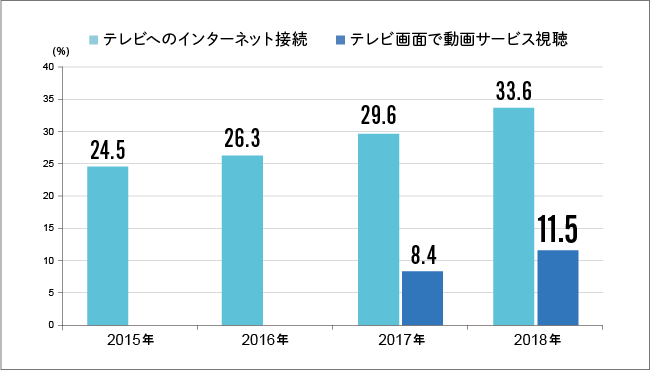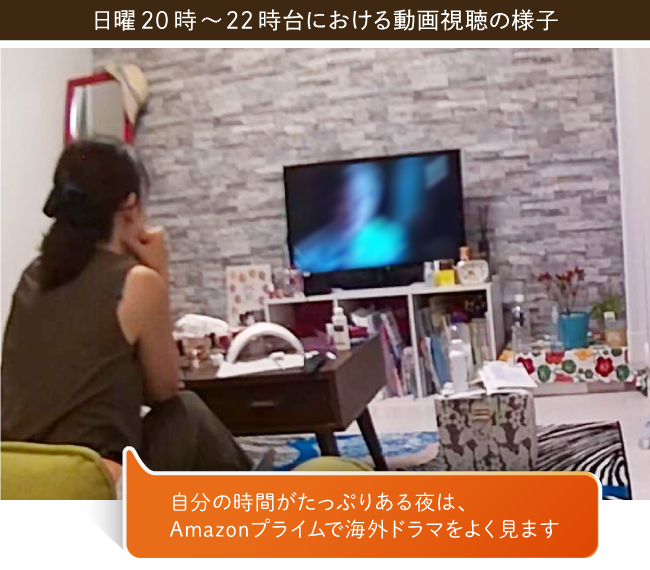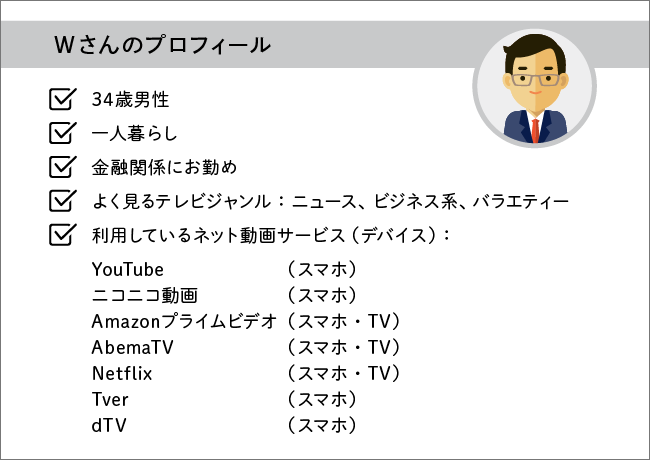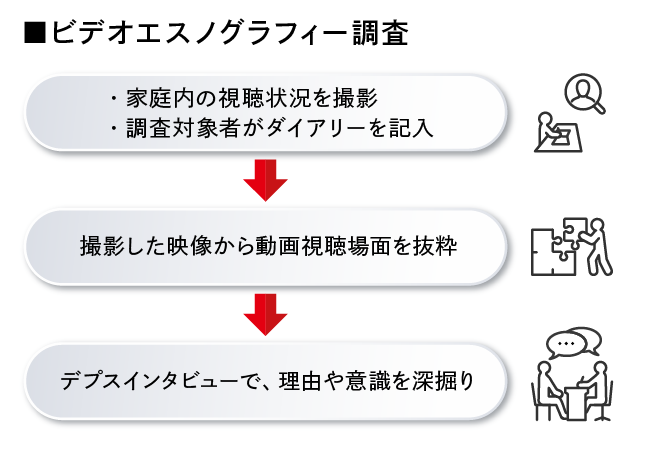Note: This website was automatically translated, so some terms or nuances may not be completely accurate.
The reality of people watching video services on TV screens

Ayako Ochiai
Video Research Ltd.
Mobile devices like smartphones and tablets are now the primary devices for watching video services.
Meanwhile, modern TVs often feature dedicated buttons for video services like "YouTube" or "Netflix" on their remotes, making it easier than ever to watch video services directly on the TV screen.
Incidentally, just over 10% of people watched video services on their TV screens in 2018. Alongside the rise in "Internet connectivity rates for TVs and TV-connected devices," the number of people "using video sharing sites or video streaming sites on TVs" is also gradually increasing.

When and what do people watch on their TV screens? Introducing the viewing habits of two survey participants
This time, we present results from the "Full Circle TV Survey," jointly conducted by Dentsu Inc. and Video Research Ltd., to understand how "people who watch video services on TV screens" consume both broadcast television and video services.
*See the end of the article for survey methodology details.
The survey prioritized understanding actual video viewing habits within natural daily life, employing "video ethnography"—observing participants at home via video recording. Here, "video" refers to both TV broadcasts and online video services. Individual interviews were also conducted with participants at a later date.
Participants were selected based on the criterion of "individuals who habitually watch not only TV broadcasts but also video services on their television sets" and kindly agreed to cooperate.
This time, we present the cases of "Ms. F, a woman in her 30s" and "Mr. W, a man in his 30s."
① Case Study: Ms. F (Woman in her 30s)

Ms. F admits she loves TV, turning it on when she wakes up in the morning and again when she returns home at night. Her total viewing time was 120 minutes on weekdays and 254 minutes on weekends, totaling 374 minutes over two days.
Of that total, television broadcast viewing accounted for 70% (277 minutes).
Despite being such a TV enthusiast, Ms. F was often seen engaging in multitasking while watching programs, constantly holding her smartphone in one hand to check social media.
Additionally, watching videos on their smartphone (mainly YouTube) had become a firmly established habit in their daily life. They did this not only during commutes but also at night while doing housework, enjoying audio-only (no video) content like music or how-to/technique videos.
■Content intended for visual enjoyment is watched on the "TV screen"
A defining characteristic of Ms. F was her clear distinction in using different video services on different viewing devices.
<Ms. F's Video Service × Viewing Device Combinations>
・For overseas dramas, where she wanted to enjoy the visuals, she watched <Amazon Prime × TV screen>
・Music videos and how-to videos, which can be enjoyed with audio only, are watched on <YouTube × Smartphone>
The main reasons for watching foreign dramas on a TV screen seem to be the larger display and the ability to relax in a comfortable position. When watching on a smartphone, he had to prop it up against a plastic bottle or tissue box, forcing him to watch while hunched over.
For video service users who frequently watch long-form content like movies and dramas, "being able to watch in a relaxed posture" might be a key factor when choosing which device to use.
■ Conscious of "disposable time," they want to choose content that maximizes satisfaction within it
Drama enthusiast F often watches dramas on weekday evenings. One criterion for choosing between "TV broadcast dramas" and "Amazon Prime foreign dramas" is the length of their "disposable time" (time they can freely use at their own discretion) that day.
When he gets home from work with 2-3 hours of free time, he often binge-watches foreign dramas (Amazon Prime). On the other hand, if he gets home late, he tends to watch live-broadcast dramas. If he missed the previous week's episode, he sometimes catches up on the missed episode via on-demand streaming on his smartphone right before continuing with the live broadcast.

Video services have content stockpiled, allowing endless viewing of series like dramas. In F's case, because they get hooked on the story, they use the video service on days when they can watch 2-3 episodes back-to-back.
This approach to maximizing satisfaction with disposable time—essentially prioritizing "time performance" when choosing content—isn't unique to F. It likely applies to most people today, constantly pressed for time.
Incidentally, in interviews with other participants besides F, we also heard comments like, "I used to record shows I couldn't watch live, but now I always have about 10 variety shows recorded regardless of whether I can watch them live or not. I watch them when there's nothing I want to see live." This made me think that maximizing satisfaction with disposable time might be changing the way people approach time-shifted viewing.
【② Case Study: Mr. W (Male, 30s)】

Mr. W spends long periods away from home, limiting his video viewing (TV broadcasts and streaming services) at home to "breakfast/getting ready," "breaks during daytime outings," and "after returning home until bedtime." His total viewing time over two days was 155 minutes.
W also watches videos while studying at a membership-based workspace, utilizing its WiFi environment for viewing content while out.
■ Is dual-screen viewing with smartphones now standard even when watching selected content?!
A common feature in both F and W's viewing scenarios was watching TV while using their smartphones.
Particularly for Mr. W, he used his smartphone not only during passive TV broadcast viewing but also when actively selecting and starting video service content. This behavior was a significant finding in this survey.
Furthermore, W stated in an interview, "When watching while using my phone, I'm not solely focused on the phone in my hand; I can grasp the content of news or variety shows just by listening to the audio." F also mentioned playing YouTube while doing housework, saying, "I can understand what's being said without looking at the screen."
It appears that a "smartphone-while-watching style" has become established: users listen to the content while handling their phone, glancing at the TV screen when something catches their interest.
A distinctive feature of Mr. W's viewing sessions was the short viewing time per content piece. Despite using the TV screen, the longest content he watched was only 26 minutes.
This is partly influenced by the genres W watches—news, business-related variety shows, and anime—which tend to be relatively short. However, even when W actively selects and starts watching something, they rarely finish it. Instead, they frequently switch to searching for other content midway through.
Particularly with AbemaTV, a video service, he uses it when he wants to watch something without a specific goal. Unlike Netflix or Amazon Prime, his viewing style resembles channel-surfing, closer to the experience of watching broadcast TV.
■Choosing services that provide the genre/content he wants to watch now
In Mr. W's case, as mentioned in the interview ("Sunday mornings put me in the mood for anime"), his desired genre was often determined by the time of day. He would then select and watch content matching that genre from either TV broadcasts or video services.
AbemaTV, which met his specific need to "watch the news around 11 PM," became firmly established in his routine. It even led to the habit of turning on AbemaTV without any particular purpose during that time slot.
W's case clearly demonstrates how crucial it is for today's consumers to receive the genres and content they want to watch at that exact moment.

Maximizing personal time performance determines viewing style
While both individuals introduced here share the behavior of "using a TV screen to watch video services," their available time at home and preferred video content genres differ. Consequently, significant differences emerged in the video services they watch and how they consume them.
However, observing both individuals strongly reinforced the realization that consumers pursue "satisfaction with their disposable time" – essentially maximizing time performance.
Pursuing time performance led to changes in viewing styles
・Ms. F focuses on content selection based on "length of free time"
・Mr. W focuses on choosing video platforms (including TV broadcasts) that offer "the content genres he wants to watch right now"
【Survey Overview】
●Research Method: Observation via home video recording (video ethnography) and depth interviews (video cameras installed in participants' homes to record two days of TV viewing; interviews conducted later while reviewing the footage)

●Survey Dates: [Case ① (Ms. F) Female, 30s] August 26 & 30, 2018: Home filming; September 9, 2018: Interview conducted
[Case 2 (Mr. W) Male in his 30s] October 20 & 21, 2018: Filming at home; November 5, 2018: Interview conducted
●Survey Name: Dentsu Inc. Video Research Ltd. Joint "Back to TV" Survey
●Target Area: Greater Tokyo Area (Tokyo and three surrounding prefectures)
● Target Criteria:
・Individuals who consistently watch videos on both TV screens and smartphones
・Excludes those who never watch broadcast TV
・Users of any major video service (YouTube, Amazon Prime Video, AbemaTV, etc.)
・Frequent social media users (Instagram, Facebook, Twitter)
・Ages 20s to 40s (excluding media and market research professionals)
●Sample size: 5 individuals
●Research organization: Video Research Ltd.
■ACR/ex
●Survey Participants: Individuals aged 12–69 (both men and women)
●Survey Area: Tokyo 50km radius
●Target Sample Size: 4,800 people
●Survey Method: Electronic questionnaire survey
●Sample Selection Method: Area-based random sampling
●Survey Period: April–June 2015/2016/2017/2018
*For details, please refer to the external link below
https://www.videor.co.jp/service/communication/acrex.html
Was this article helpful?
Newsletter registration is here
We select and publish important news every day
For inquiries about this article
Author

Ayako Ochiai
Video Research Ltd.
Human Research Institute
After working in sales at an online research company, he joined Video Research Ltd. in 2011. Leveraging his experience analyzing ACR/ex single-source consumer data and insights gained from consumer research, he is dedicated to planning and promoting the digitalization of television.
